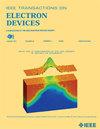Interface Engineering for Hysteresis-Free, High-Performance, and Stable a-IGO Thin-Film Transistors
IF 2.9
2区 工程技术
Q2 ENGINEERING, ELECTRICAL & ELECTRONIC
引用次数: 0
Abstract
The instability of oxide thin-film transistors (TFTs) remains a critical concern that demands attention. Herein, interface engineering was employed to enhance the performance of amorphous indium gallium oxide (a-IGO) TFTs. The Al2O3 sandwich-encapsulation a-IGO TFTs demonstrate outstanding electrical characteristics and remarkable stability, evidenced by an average field-effect mobility of 33.1 cm无迟滞、高性能、稳定的a-IGO薄膜晶体管的接口工程
氧化物薄膜晶体管(TFTs)的不稳定性一直是一个值得关注的问题。本文采用界面工程技术提高了非晶氧化铟镓tft的性能。Al2O3夹层封装的a-IGO TFTs具有优异的电学特性和稳定性,平均场效应迁移率为33.1 cm $^{{2}} \cdot $ V $^{-{1}}$ s $^{-{1}}$,亚阈值摆幅为0.19 V/dec,通断比为$10^{{7}}$。值得注意的是,最令人惊讶的特点在于它能够实现极低的磁滞,仅为0.04 V。此外,在经受3600 s的正偏置应力(PBS) (+2 V)和负偏置应力(NBS) (- 2 V)后,阈值电压分别发生了0.1 V和0.08 V的微小位移。此外,该设备在环境条件下的使用寿命值得注意,暴露60天后移动率仅下降1.2%,突出了其卓越的环境稳定性。这些器件性能的增强可归因于缺陷自补偿效应,这导致三明治结构器件中a-IGO薄膜缺陷的减少。结果表明,三明治封装的IGO tft在下一代显示行业中具有很高的前景。
本文章由计算机程序翻译,如有差异,请以英文原文为准。
求助全文
约1分钟内获得全文
求助全文
来源期刊

IEEE Transactions on Electron Devices
工程技术-工程:电子与电气
CiteScore
5.80
自引率
16.10%
发文量
937
审稿时长
3.8 months
期刊介绍:
IEEE Transactions on Electron Devices publishes original and significant contributions relating to the theory, modeling, design, performance and reliability of electron and ion integrated circuit devices and interconnects, involving insulators, metals, organic materials, micro-plasmas, semiconductors, quantum-effect structures, vacuum devices, and emerging materials with applications in bioelectronics, biomedical electronics, computation, communications, displays, microelectromechanics, imaging, micro-actuators, nanoelectronics, optoelectronics, photovoltaics, power ICs and micro-sensors. Tutorial and review papers on these subjects are also published and occasional special issues appear to present a collection of papers which treat particular areas in more depth and breadth.
 求助内容:
求助内容: 应助结果提醒方式:
应助结果提醒方式:


